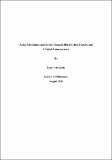| dc.contributor.advisor | O'Donnell, Martin | |
| dc.contributor.author | McGrath, E | |
| dc.date.accessioned | 2013-10-15T14:13:53Z | |
| dc.date.issued | 2013-08-28 | |
| dc.identifier.uri | http://hdl.handle.net/10379/3748 | |
| dc.description.abstract | Stroke is a leading cause of adult disability and the third leading cause of mortality in developed countries. Atrial fibrillation is a major risk factor for ischaemic stroke, associated with a five-fold increase in risk. When patients with atrial fibrillation suffer an ischaemic stroke, they have a two-fold increased risk of subsequent disability and death, compared to patients without atrial fibrillation. Oral anticoagulants (e.g. warfarin) reduce the risk of ischaemic stroke in patients with atrial fibrillation by two-thirds. However, they also increase bleeding risk, most importantly intracerebral haemorrhage.
Employing a number of approaches to statistical analyses, this thesis addresses the following areas: 1) the comparative importance of risk factors for ischaemic stroke and intracerebral haemorrhage in patients with stroke and atrial fibrillation, with a particular emphasis on risk factors common to both stroke types, 2) the natural history of acute ischaemic stroke in patients with atrial fibrillation and the clinical factors which explain the association between atrial fibrillation and increased mortality and disability following acute ischaemic stroke, and 3) the association between different antithrombotic regimens on discharge and risk of major vascular events and bleeding in patients with atrial fibrillation following acute ischaemic stroke, with a particular focus on patients with severe stroke and those with coronary artery disease. This thesis also evaluates the association between participation in Heartwatch, a risk factor modification program for the secondary prevention of cardiovascular disease, and subsequent risk of stroke and other major vascular events in patients with prior stroke or coronary artery disease.
This content provides novel information which furthers our understanding of the association between atrial fibrillation and poor stroke outcomes, helps to optimise selection of antithrombotic therapy in patients with atrial fibrillation, and investigates the potential of Heartwatch as a primary-care based programme for the secondary prevention of stroke and cardiovascular disease. | en_US |
| dc.rights | Attribution-NonCommercial-NoDerivs 3.0 Ireland | |
| dc.rights.uri | https://creativecommons.org/licenses/by-nc-nd/3.0/ie/ | |
| dc.subject | Stroke | en_US |
| dc.subject | Atrial fibrillation | en_US |
| dc.subject | Medicine | en_US |
| dc.title | Atrial Fibrillation and Stroke: Natural History, Risk Factors and Clinical Consequences | en_US |
| dc.type | Thesis | en_US |
| dc.contributor.funder | Health Research Board | en_US |
| dc.local.note | Stroke is a leading cause of adult disability and mortality in developed countries. Atrial fibrillation, an irregular heart rhythm, is a major risk factor for ischaemic stroke, associated with a five-fold increase in risk. When patients with atrial fibrillation suffer an ischaemic stroke, they have a two-fold increased risk of subsequent disability and death, compared to patients without atrial fibrillation. Oral anticoagulants (e.g. warfarin) reduce the risk of ischaemic stroke in patients with atrial fibrillation by two-thirds. However, they also increase bleeding risk, most importantly intracerebral haemorrhage. This thesis addresses the following areas: 1) the comparative importance of risk factors for ischaemic stroke and intracerebral haemorrhage in patients with stroke and atrial fibrillation, 2) the natural history of acute ischaemic stroke in patients with atrial fibrillation and the clinical factors which explain the association between atrial fibrillation and increased mortality and disability following acute ischaemic stroke, and 3) the association between different antithrombotic regimens on discharge and risk of major vascular events and bleeding in patients with atrial fibrillation following acute ischaemic stroke. This thesis also evaluates the association between participation in Heartwatch, a risk factor modification program for the secondary prevention of cardiovascular disease, and subsequent risk of stroke and other major vascular events in patients with prior stroke or coronary artery disease. | en_US |
| dc.local.final | Yes | en_US |
| nui.item.downloads | 4 | |


